Keiki Cloning Paste – A lot of conversation is currently happening on Social Media regarding the effects of Keiki paste on plants.
Some people claim it works great, while others say it didn’t work for them at all.
The idea is to apply the paste on the nodes of plants, such as orchids, to produce clones of the mother plant. These clones are called Keikis in the case of orchids.
Keiki is a Hawaiian word for baby and is used as a name for small baby orchids. One type of orchid where the Keiki paste works specifically well is the Phalaenopsis orchid.
Plantophiles.com participates in affiliate advertising programs designed to provide a means for sites to earn advertising fees by advertising and linking to affiliates. We earn from qualifying purchases.
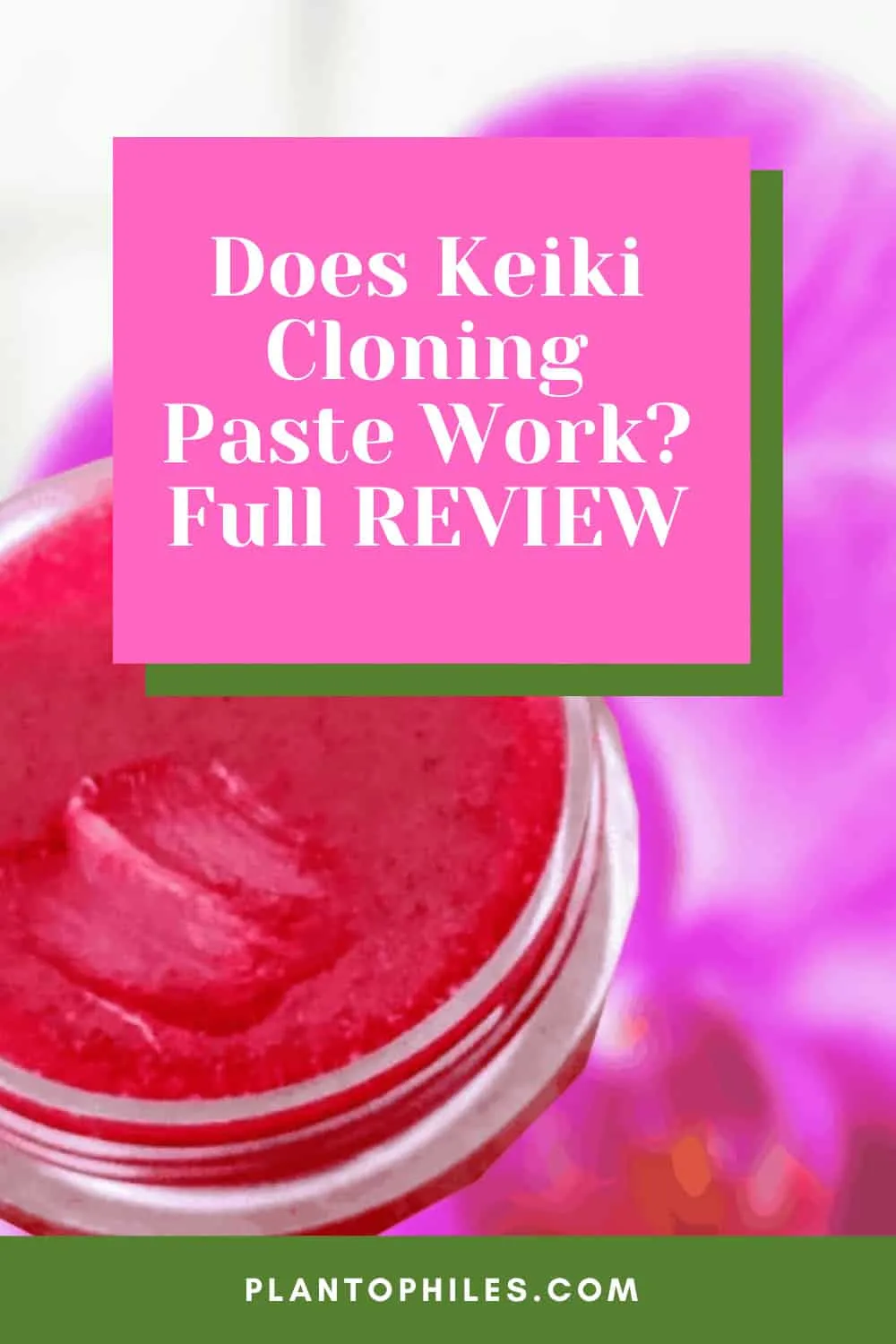
Does Keiki Cloning Paste Work Full REVIEW
Keiki Cloning Paste
Keiki cloning paste is a paste that is applied to the nodes of orchids to produce new baby plantlets or keikis. The offsprings are 100% clones of the mother plant. Cloning paste can also produce new growth on other plants, such as Philodendron and Monstera. The pastes contain growth hormones called cytokinin, such as kinetin responsible for cell division. They often also contain auxin to regulate growth. Lanolin, on the other hand, is used to create a paste-like substance. Keiki Cloning Paste does work, but positive results are not guaranteed.
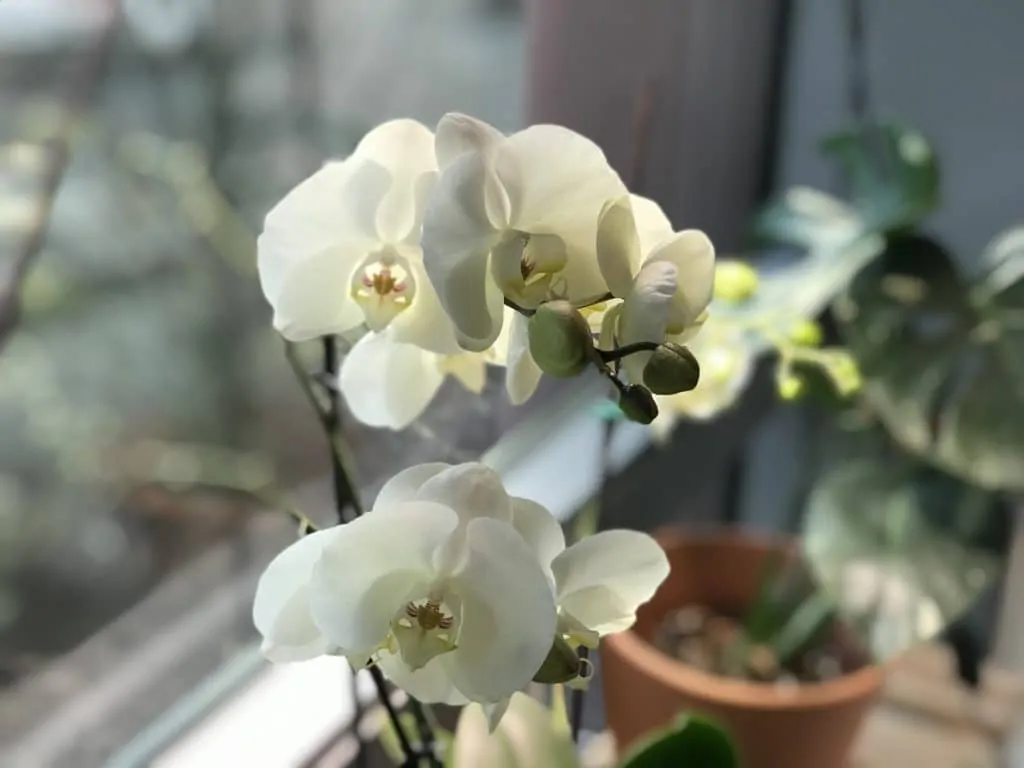
Phalaenopsis orchid in full bloom. Better not to apply the Keiki Paste during this time as the energy is needed for the flowers.
Best Keiki Pastes
You can order this selection of great Keiki pastes directly from Amazon.
Table of Contents
How do Keikis grow?
Little plantlets on orchids or Keikis can either grow naturally, or the product can be induced by using plant hormones found in cloning pastes.
To be honest, I have never seen an orchid produce a little plantlet by itself, but it is said to happen occasionally. The Keikis do emerge in the same way new flower spikes would.
First, the node starts to swell, and within a couple of days or weeks, you see something emerging from the node. When it is a Keiki, you will see a fist-like green thing growing.
Once leaves grow on it, you can say with certainty that it is a little baby orchid. Unlike propagation from seeds, new orchids derived this way are perfect clones of their mother plants.
A different way to propagate orchids would be through pollination. In nature, this happens through natural pollinators, whereas in cultivation, you must hand-pollinate the plants.
A tedious process that requires a 100% sterile environment and flasking of the seeds once ready, and a lot of patience.
It is important to mention that the Keiki Cloning Paste does not always work as intended. Sometimes nothing will emerge from the buds where the Keiki Paste is applied.
On other occasions, you will get a flower stem and flowers instead of Keikis. I guess most people can live with that, can’t they?
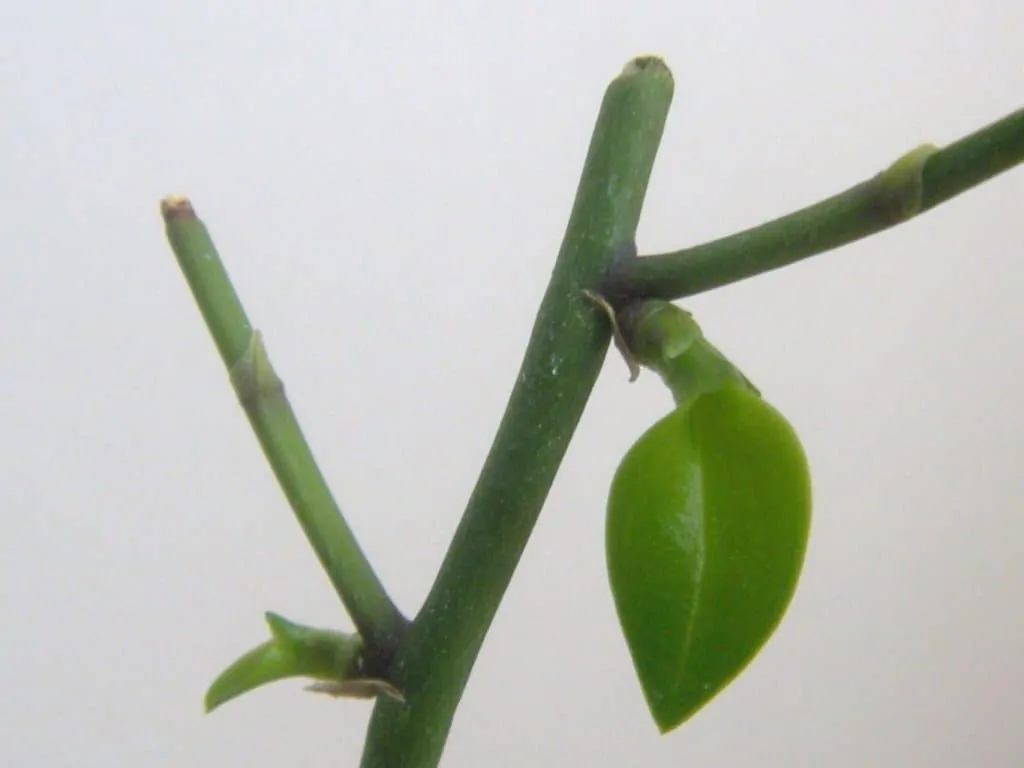
Keiki formin on a Phalaenopsis equestris
Can Keiki Cloning Paste be used for other Monstera or Philodendron plants?
Plant enthusiasts started experimenting with Keiki paste on other plants, such as Philodendron, Monstera, and other houseplants.
If it works for orchids, why wouldn’t it work on a Philodendron Gloriosum?
But does the Keiki Cloning Paste work at all? These are the questions we would like to answer in this article.
What is Keiki Cloning Paste?
Keiki cloning paste contains a hormone called cytokinin that encourages cell division.
According to the NC State University one of the cytokinin used and approved in the US is benzyladenine (BA).
In addition, lanolin is used as a carrier medium to hold the plant hormone cytokinin and for easy application onto the plant.
As the name suggests, the lanolin gives the Keiki Cloning Paste a paste-like consistency.
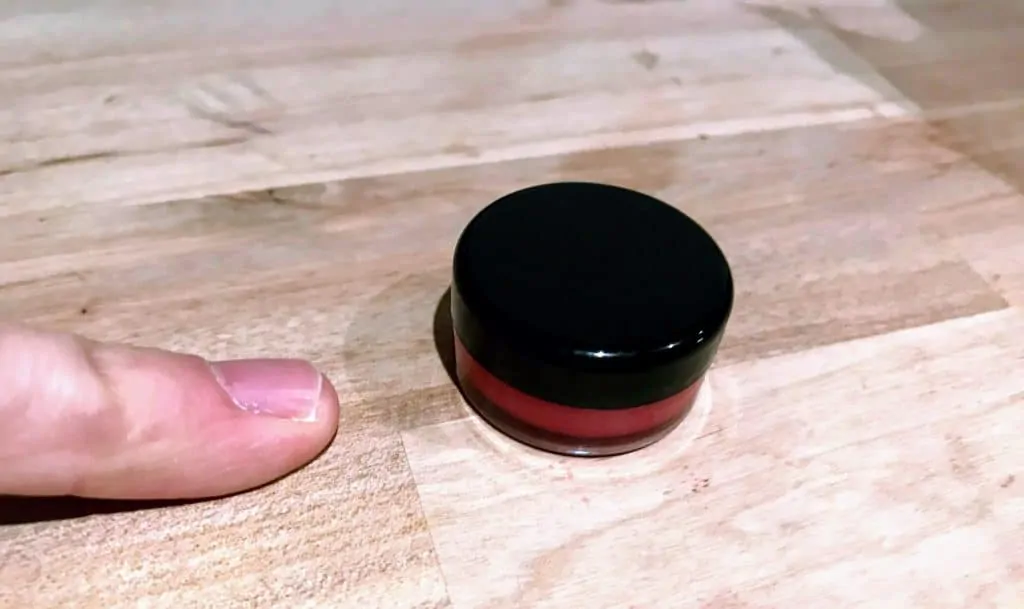
Keiki Cloning Paste – A small-sized tub like this will last for many applications
Cytokinin
Cytokinin (CK) belongs to a class of plant growth substances. Plant hormones control all aspects of a plant. Cytokinin specifically promotes cell division in plant roots and shoots.
Cytokinins work with Auxins, another plant hormone often found in Keiki Pastes. Auxins are essential for plant body development.
A higher concentration of Cytokinin increases the growth of shoot buds, and more Auxin increases the chance of root development. Folke Skoog was the first person to discover the effects of Cytokinin when using Coconut Milk in the 1940s.
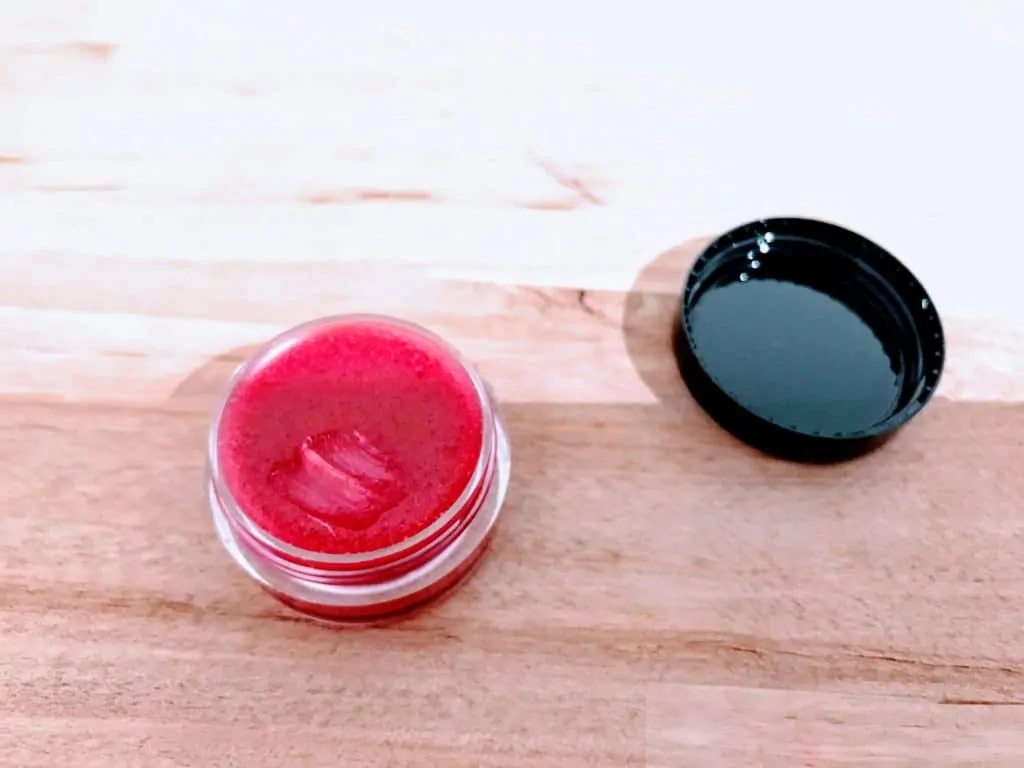
Keiki Cloning Paste contains a growth hormone called Cytokinin inside
How much of the Keiki Paste do I need?
The answer is very little.
The paste is usually sold in very small dosages of a few ml (2-10 ml and more).
The paste is applied locally, and very little is sufficient to have the desired effect. Therefore even a little tub of 5ml will last a long time, and many applications are possible.
How to use the Keiki Cloning Paste
Alright, you bought a Keiki paste of some sort, and now you want to apply it to either your orchid, most likely a Phalaenopsis, or if you are brave, you are ready to apply the paste on your priced Monstera and Philodendron plants.
What you will need for your cloning operation
These are the items you will most likely need for a successful plant cloning operation:
- The Keiki Cloning Paste (obviously)
- A cotton swab and toothpick to apply the paste
- Gloves
- Knife or tweezers
- Rubbing alcohol to sterilize your instruments
- that’s all ya folks…
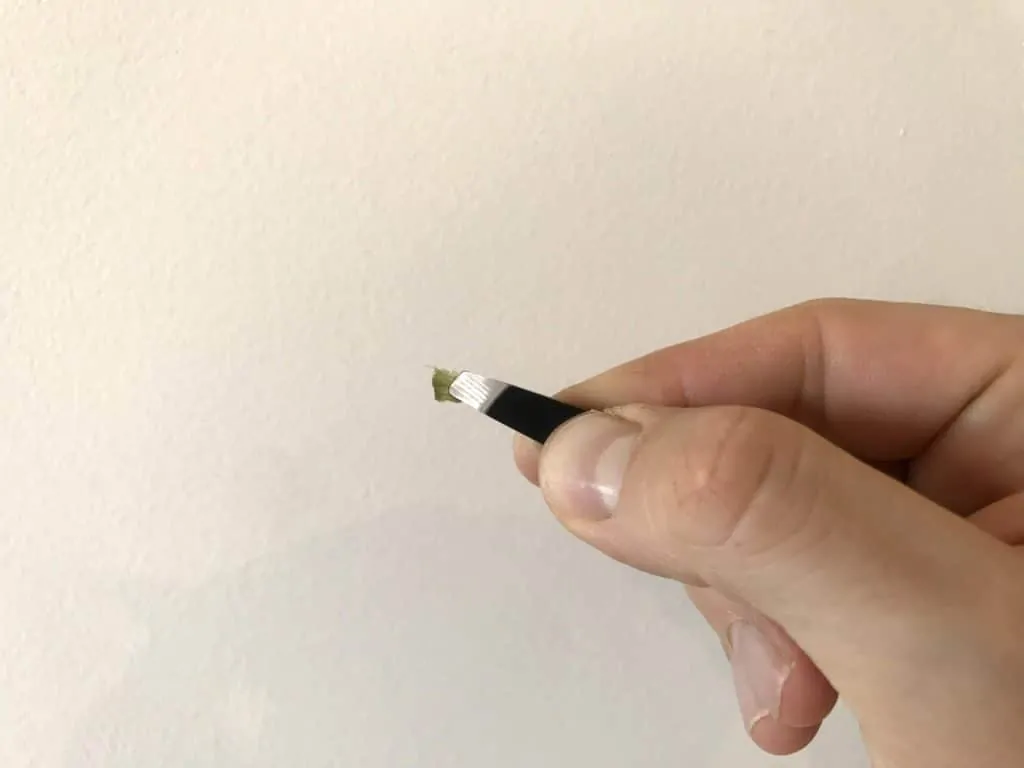
Tweezers work great to remove the cover from the eye (node) of an orchid
We highly advise using gloves when working with the Keiki Paste. We are dealing with a growth hormone. Our goal is to clone the plant and not our hands or fingers.
The cotton swab or toothpick will help you to get the paste out of the plastic container and apply it to the plant of your choice.
Steps on how to apply Keiki Paste on orchids or any other plant:
1. Find a node on the stalk/stem of your plant.
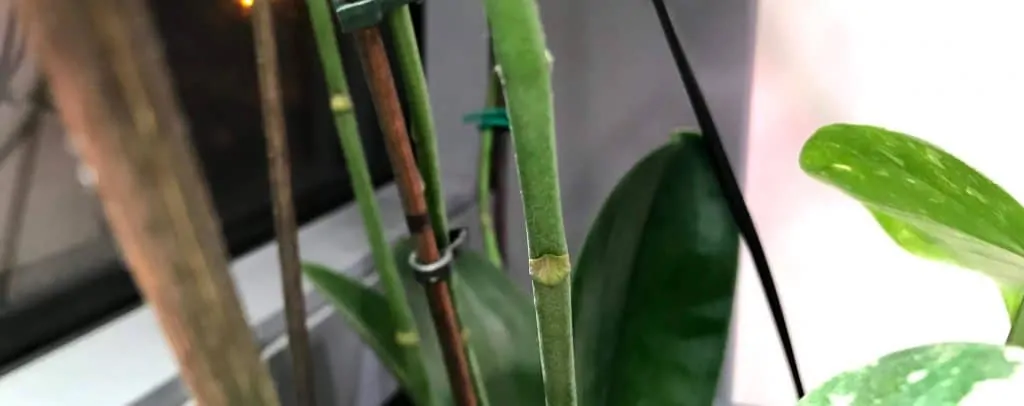
Node on Phalaenopsis orchid
2. If you are dealing with an orchid, you will first need to remove the bract covering the nodes on the orchid. You can select the instrument of choice using tweezers, a knife, or a toothpick to do the job.
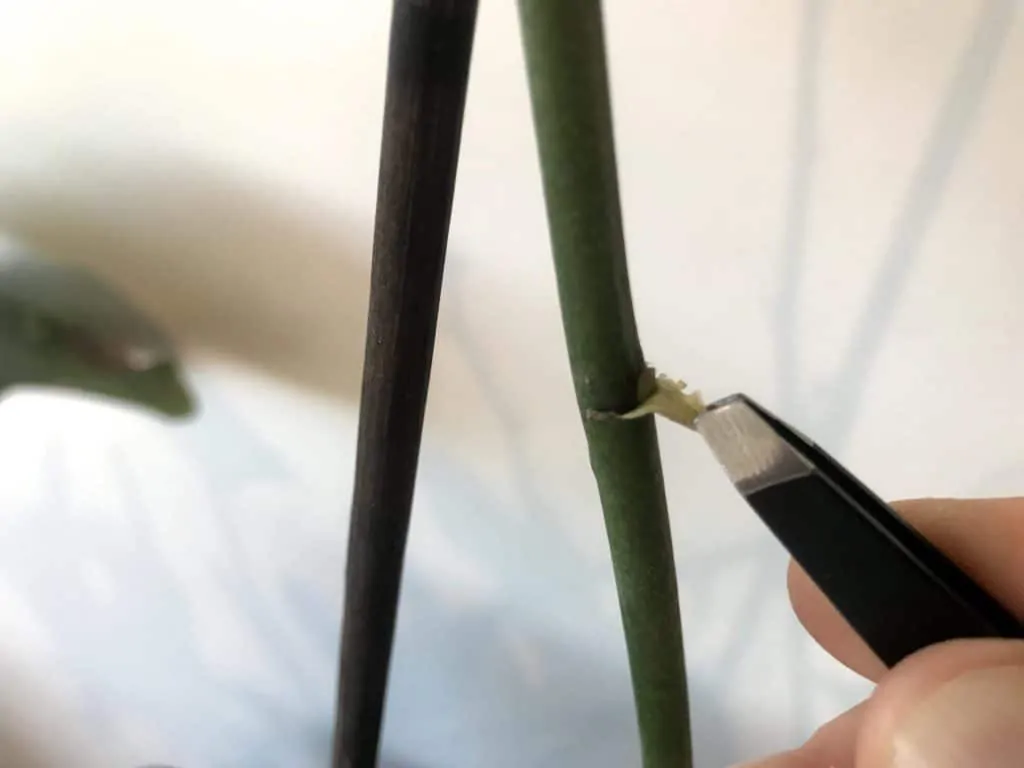
We used tweezers to remove the protective tissue called bract from the eye of an orchid
3. Once the bract or the little foliar covering the nodes is gone, you should easily spot the node. The node tissue is also called the eye on the orchid.

Orchid eye laid open and ready for Keiki paste to be applied
4. (Optional Step) Some suggest cutting slightly into the node of the orchid before applying the paste. It can increase the chance that the hormone reaches the designated area in your plant. From our experience, this is not a necessary step, and you may move from steps 3 to 5 directly.
5. Using a cotton swab or toothpick, the next step is to apply Keiki Cloning Paste on the node of the orchid or Philodendron / Monstera.
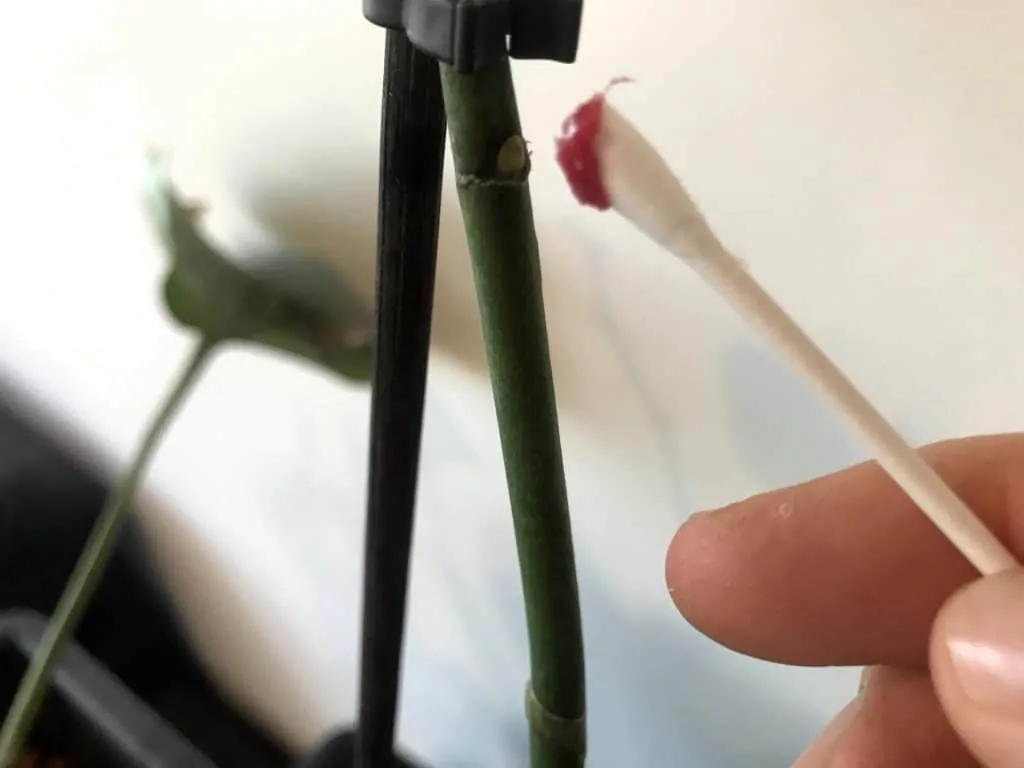
Keiki Paste on Cotton Swab – Let’s produce some orchid Keikis
6. Apply very little of the Cloning Paste on the node. Paint a star or any shape you like when applying the paste.
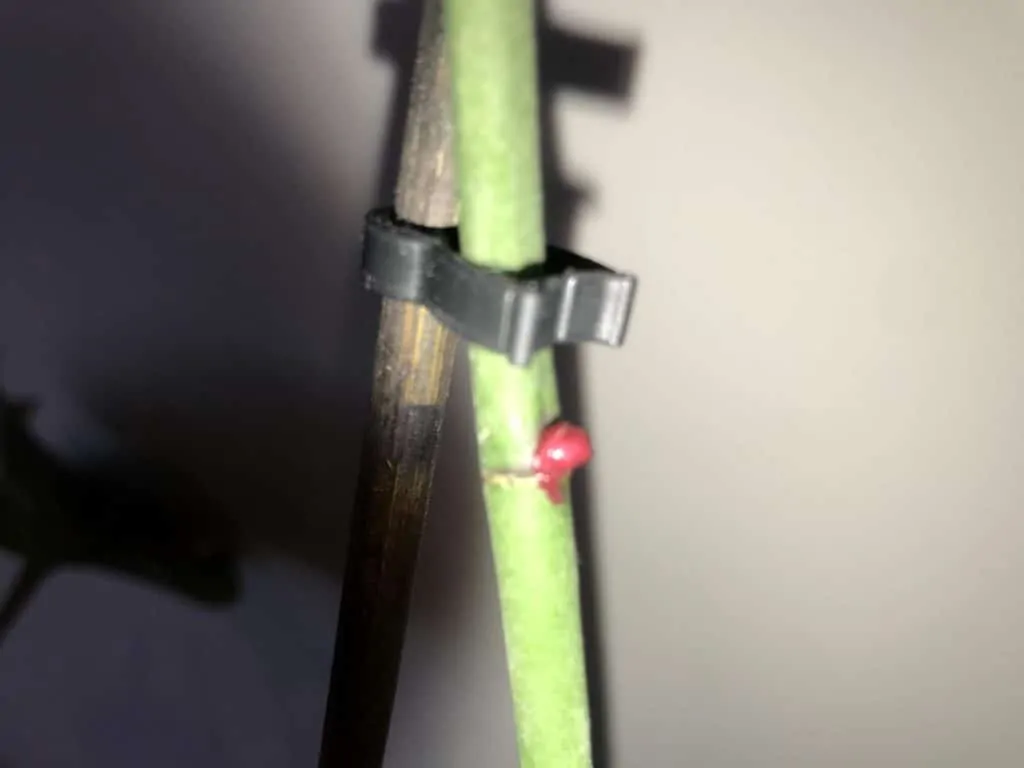
It will generally take 4-8 weeks after applying Keiki Cloning Paste to see considerable effects
7. Note when you applied the paste and check every few days.
8. On orchids, Keikis will emerge within 2-8 weeks. But be aware that you are almost equally likely to get a flower spike instead of a Keiki.
How to remove a Keiki
You have gotten to the step where something emerges from your orchid’s stalk.
This can happen sooner or later in 2-8 weeks, depending on the time of the year, the health of your orchid and the growth conditions your orchid plant is growing, and many more.
It will either be a Keiki, so a new perfect clone of your mother plant, or it is a flower stalk.
The easiest way to tell them apart is to look very closely. If it looks very smooth, it is most likely a flower spike. If it is rather bumpy, chances are high that it might be a new plant.
Once you see little leaves emerging from the stem, you will know it is a Keiki.
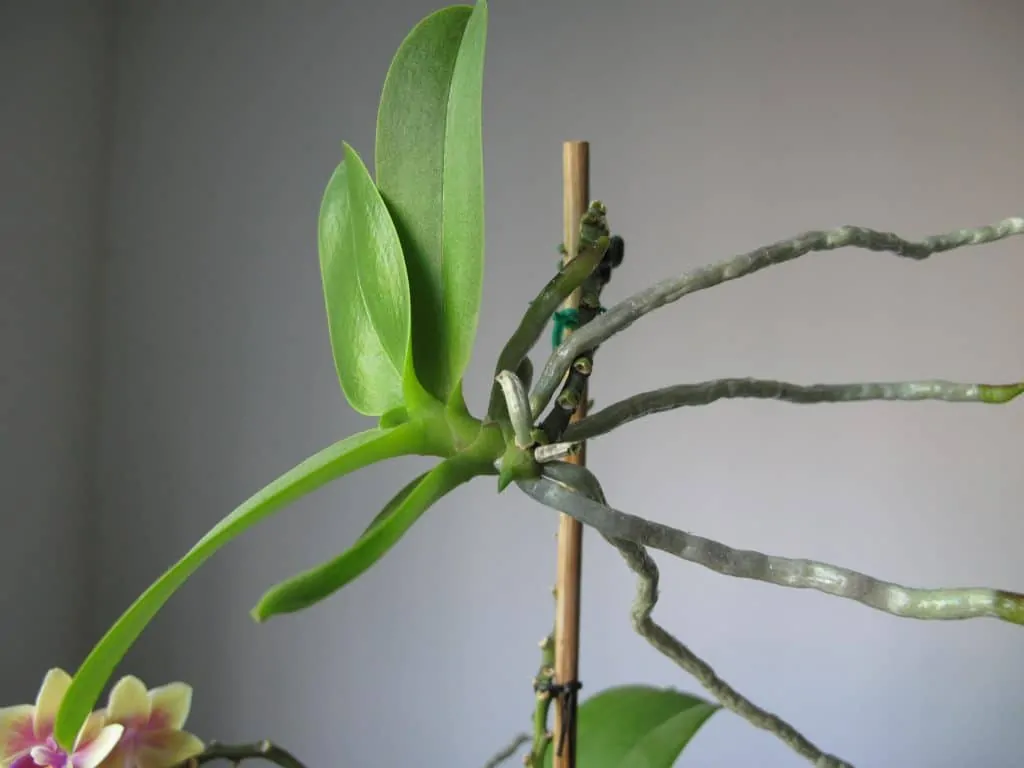
Orchid Keiki ready to be separated from the mother plant
Wait until the Keiki has its own roots with a length between 1-3” or 2.6- 7.6cm long before removing it.
Cut the Keiki at the Keik stem below the roots with a sterile knife or scissors, as the roots will be needed for the baby plant to develop.
Once you remove the plantlet, you can put it in slightly moist Sphagnum Moss or your medium of choice and grow it as you would grow any other orchid. SUCCESS!!!
Does Keiki Paste Work? The Keiki Cloning Paste Review
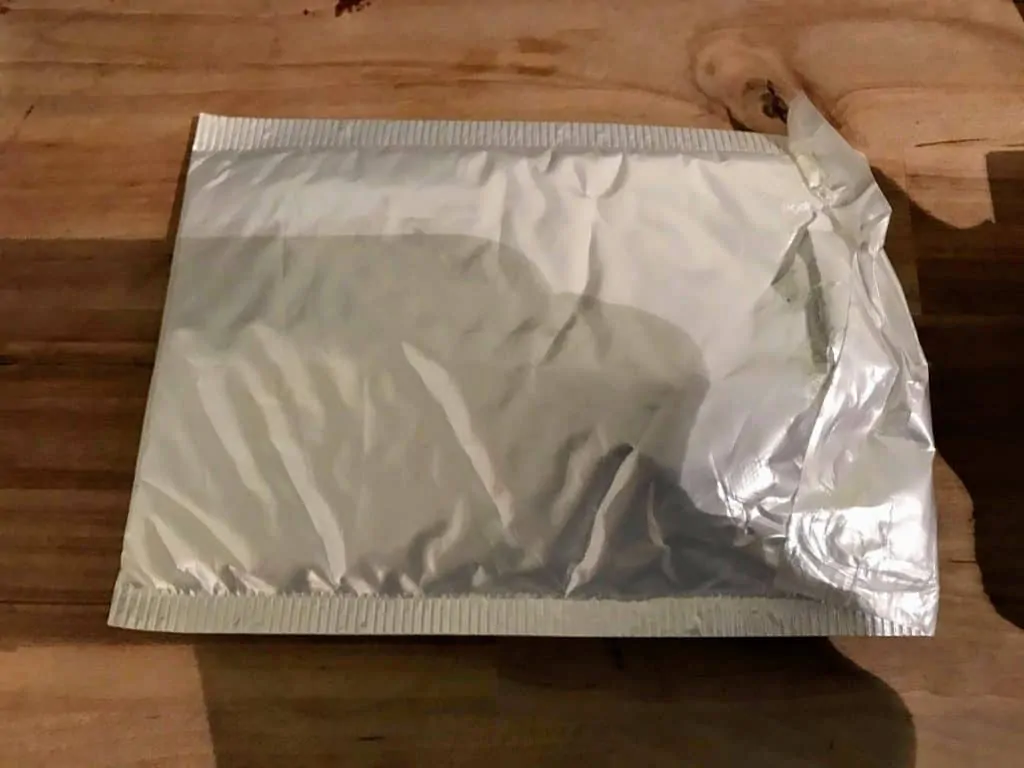
The Keiki Paste I used has arrived from a seller in Greece and is ready for action
I took the plunge and am reviewing a Keiki Cloning Paste bought from eBay for you.
We are not only going to put it on our Phalaenopsis orchid but also apply the cloning paste on several other plants:
- Phalaenopsis orchid
- Monstera Noid (former Monstera Epipremnoides)
- Philodendron El Choco Red
- Philodendron Gloriosum
- Mystery Philodendron
In the coming section, I will show you how the plants looked when we applied the paste.
I will update you on the development regularly and update the blog post once we see any development derived from applying the Keiki Paste.
Let me now briefly introduce our test subjects (results updated!):
Phalaenopsis orchid or moth orchid
This is the OG.
The Keiki paste was originally made for orchids and works best on Phalaenopsis orchids.
Moth orchids are epiphytes and grow on trees and other plants.
They are native to China, India, Southeast Asia, New Guinea, Australia, Indonesia, and the Philippines.
They are very common in cultivation and are the kind of orchids you come across in-plant shops and garden centers but also in supermarkets.
This doesn’t take anything away from their beauty at all.
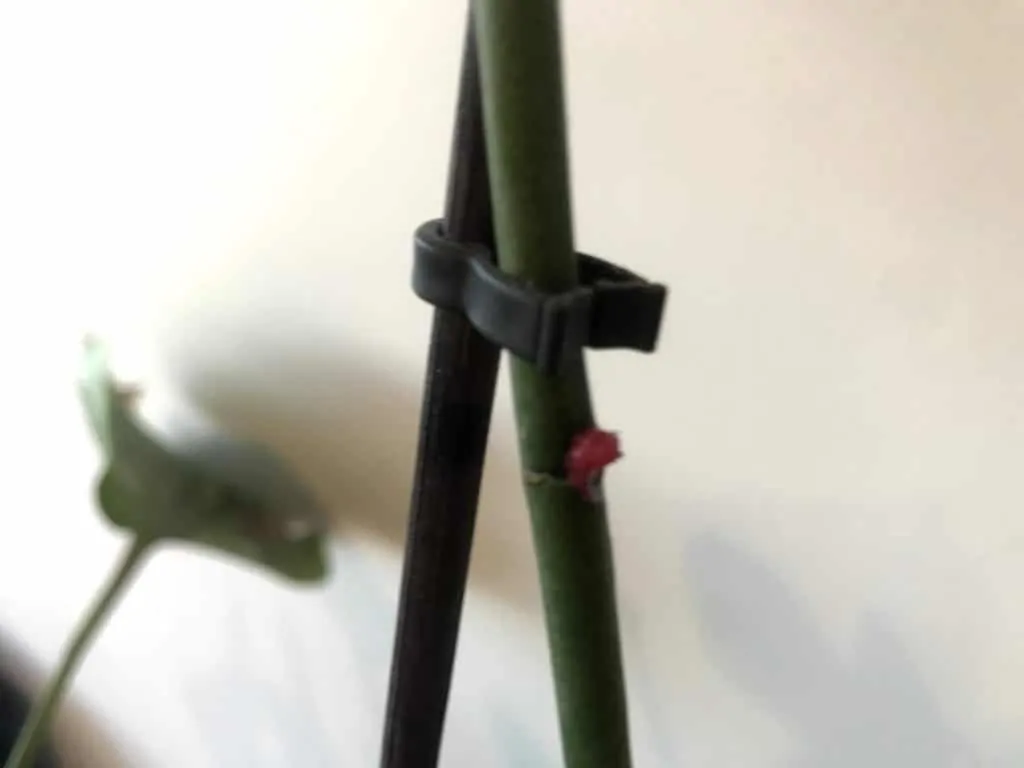
Keiki paste was successfully applied onto our Phalaenopsis orchid (paste applied on January 19th)
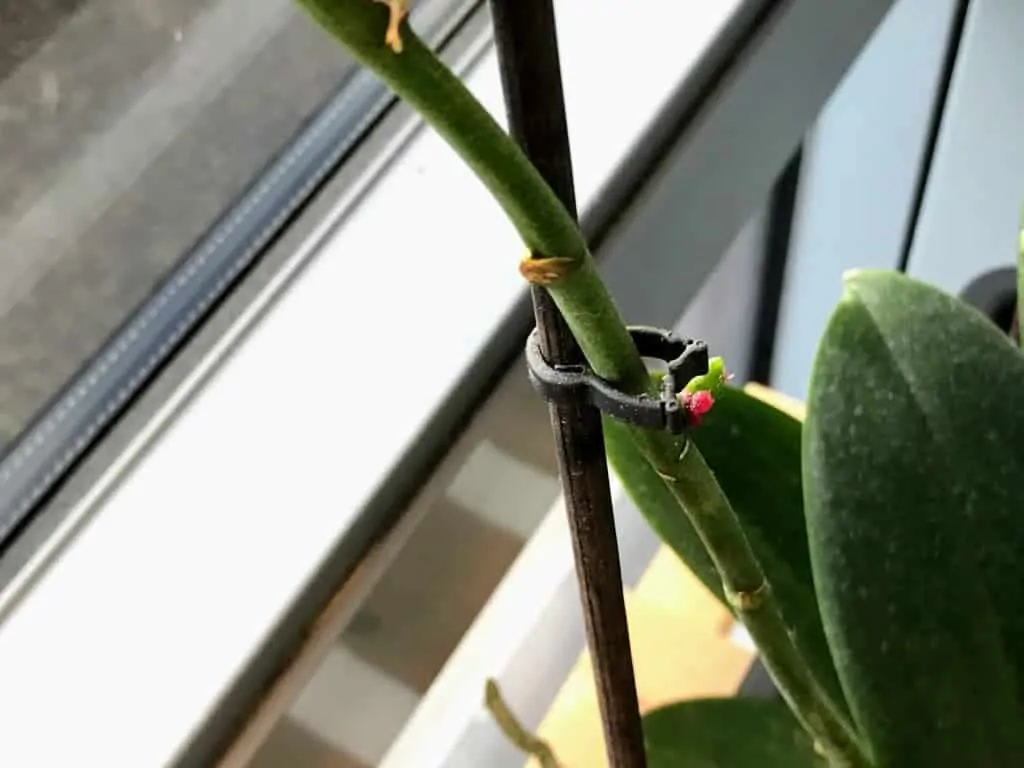
Growing Keiki after using Keiki Paste. It works! (March 8th)
Results:
I applied the Keiki paste onto two different orchids.
These orchids started to grow a Keiki or new plant where the past was applied!
The only caveat is that one of the mother orchids didn’t make it.
The reason was that I applied the Keiki paste when the orchid was in flower.
I learned from this experience that you should never apply Keiki paste when orchids bear flowers as the energy needed to maintain and develop the flowers and grow a baby is too much to take.
On the other hand, I have since applied Keiki paste to many other orchids, and it works great. Keiki pate does work amazingly on Orchids.
Applying Keiki Paste On Monstera Noid (former Monstera Epipremnoides)
Monstera Noid or Esqueleto is notoriously hard to find Monstera.
It has beautiful foliage that, even in the immature stage of the plant, is getting quite big.
It is often confused with Monstera Adansonii as it has the same slit leaves and a similar vining growth habit.
Small plants of Monstera Epipremnoides (or more recently described as Monstera Noid) are, therefore, hard to be differentiated from Adansonii.
The main difference is the rarity and price.
The Noid is considerably more expensive. What better plant to clone and produce more growth points? That’s what we thought as well.
After applying the Keiki Cloning Paste on a semi-dormant node, these are our results. Without the cloning paste application, we are sure that no growth point would have developed from the applied node.
We applied the paste on all plants on January 14th. Just four days later, on January 18th, we see absolutely nothing.
Some people talking about the effects of Keiki Paste on the Internet mention that they see a bulking up, or at least something happening on the stem after just three days. To be honest, we couldn’t see anything: no growth points and no leaves emerging so far.
Results:
The Monstera Esqueleto started a new growth point where the paste was applied. But this certainly did not happen overnight, and I would say that it took at least half a year.
Even now, although the new growth point has started growing, it has not yet developed a new leaf.
But it certainly shows that it can be done and that Keiki paste does not only work for Orchids but also Philodendron and Monstera plants.
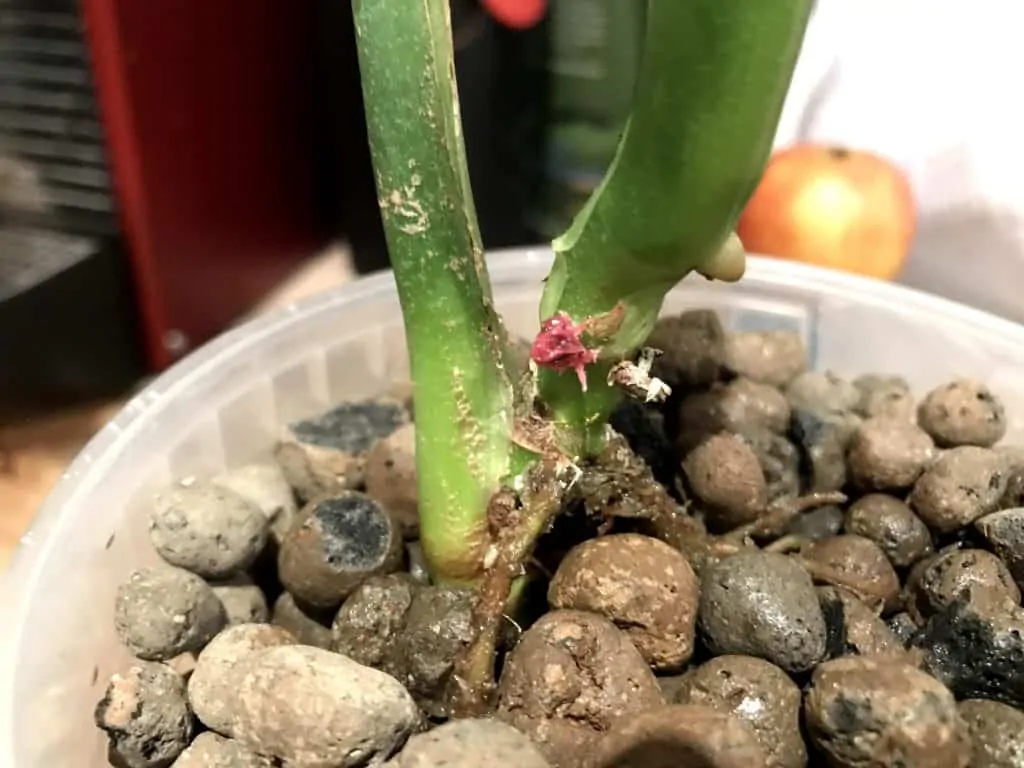
Application of Keiki Cloning Paste on Monstera Epipremnoides (paste applied on January 14th)
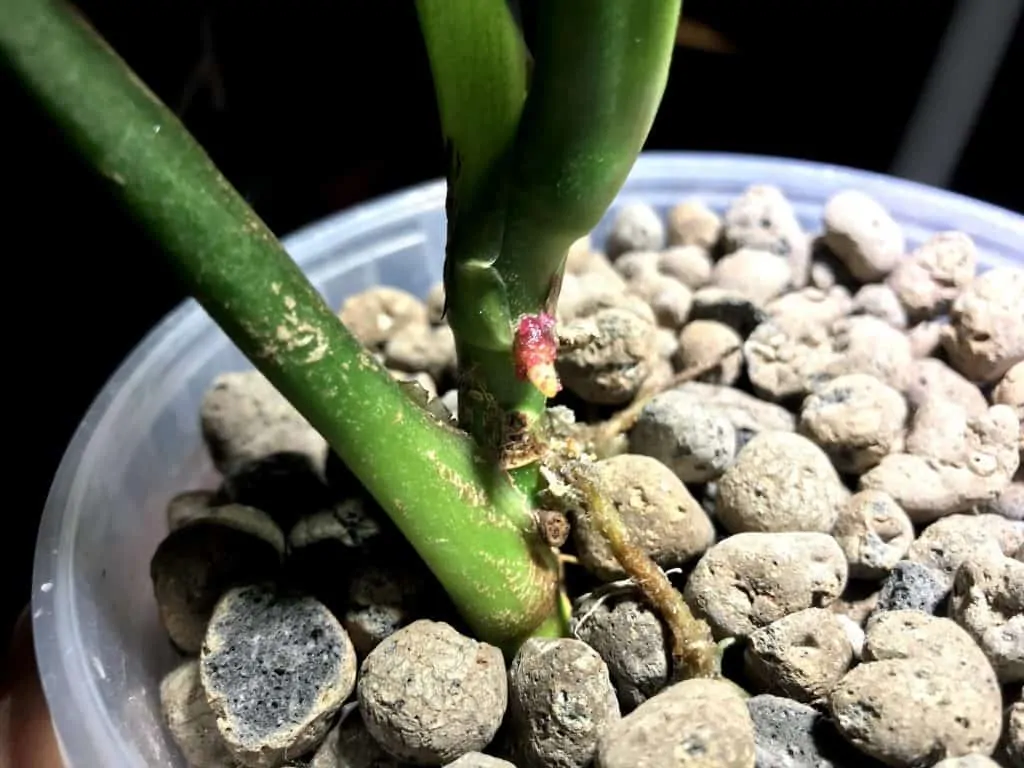
Something is growing on the Monstera Epipremnoides, known as Monstera NOID or Esqueleto. At this stage, it could be anything. Will it be an air root, or could it be a new shoot? (updated on January 27th, 13 days after the application of Keiki paste)
It turned out that the Monstera Epipremnoides just produced another air root which the Keiki paste was applied to.
Applying Keiki Paste On Philodendron El Choco Red
The contestant Nr.3 is the Philodendron El Choco Red.
A beautiful Philodendron that has not yet been described and traded as an absolute rarity and has not yet received the attention on Social Media and the houseplant community it deserves.
It already is a fast grower, but a few more growth points wouldn’t hurt. Would they?
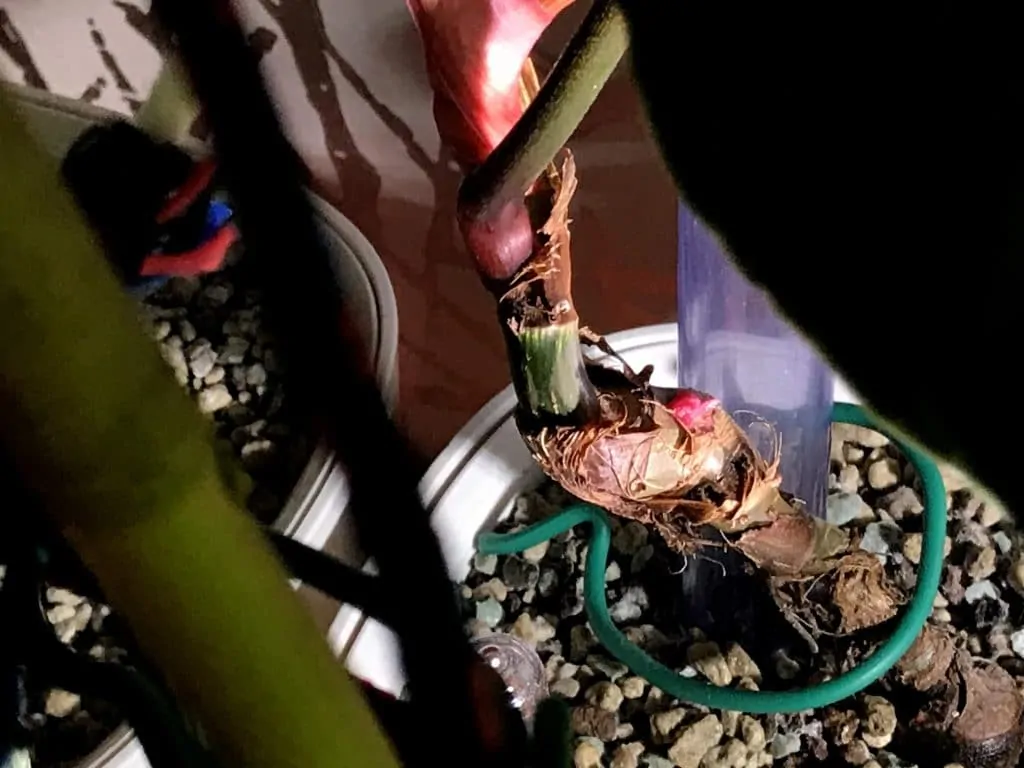
Philodendron El Choco Red with Keiki Cloning Paste (paste applied on January 14th)
Results:
Nothing ever emerged from where the Keiki paste was applied.
Philodendron gloriosum
Our fourth candidate, for whom we applied the Keiki Cloning Paste, is a mature Philodendron gloriosum.
One of my favorite plants is a Philodendron with huge heart-shaped velvety leaves that crawl on the ground.
What if I could produce another growth point that I could later separate and produce another Gloriosum plant with?
I would have our money on the Keiki paste back tenfold quickly. But did it work?
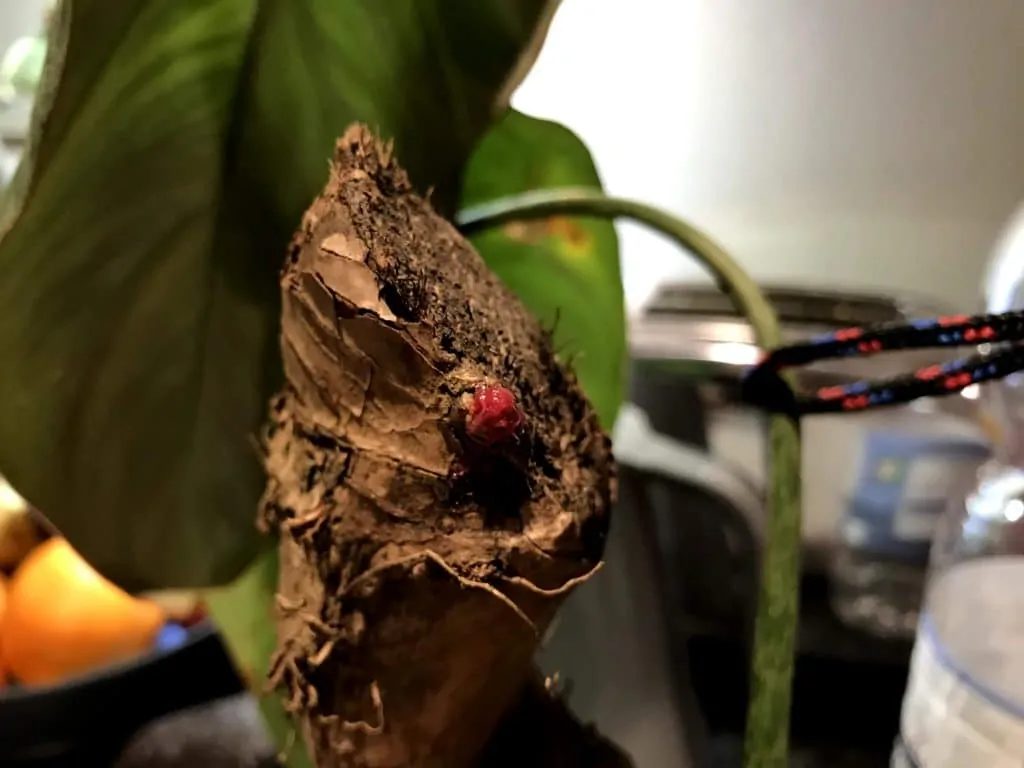
Keiki Paste on abandoned growth point on mature Philodendron Gloriosum stem (paste applied on January 14th)
Results:
I applied the Keiki paste to two growth points on my Philodendron gloriosum.
The older growth (the one you see in this picture) did not develop anything.
The newer growth point, however, started to grow almost instantly and has produced a new leaf and is growing further.
This is fantastic and has sped up the process considerably. I recommend trying a cytokinin-based Keiki paste on your aroids, although it is hit or miss from my experience.
Unfortunately, I haven’t taken a picture of it, but you must take my word.
Mystery Philodendron
And then, finally, I applied the cloning paste to the mystery Philodendron I bought a few months ago.
It was sold to us as a Philodendron Sodiroi.
While we can see some similarities, my Philodendron is certainly different.
However and whatever it may be, the Mystery Philodendron is a heart-leaf-shaped beauty; yes, I love it, and I can’t deny that I would just love to have more of this plant.
Therefore on with the cloning application, and off, we go.
We applied the paste in two spots to increase our chances of at least seeing some growth.
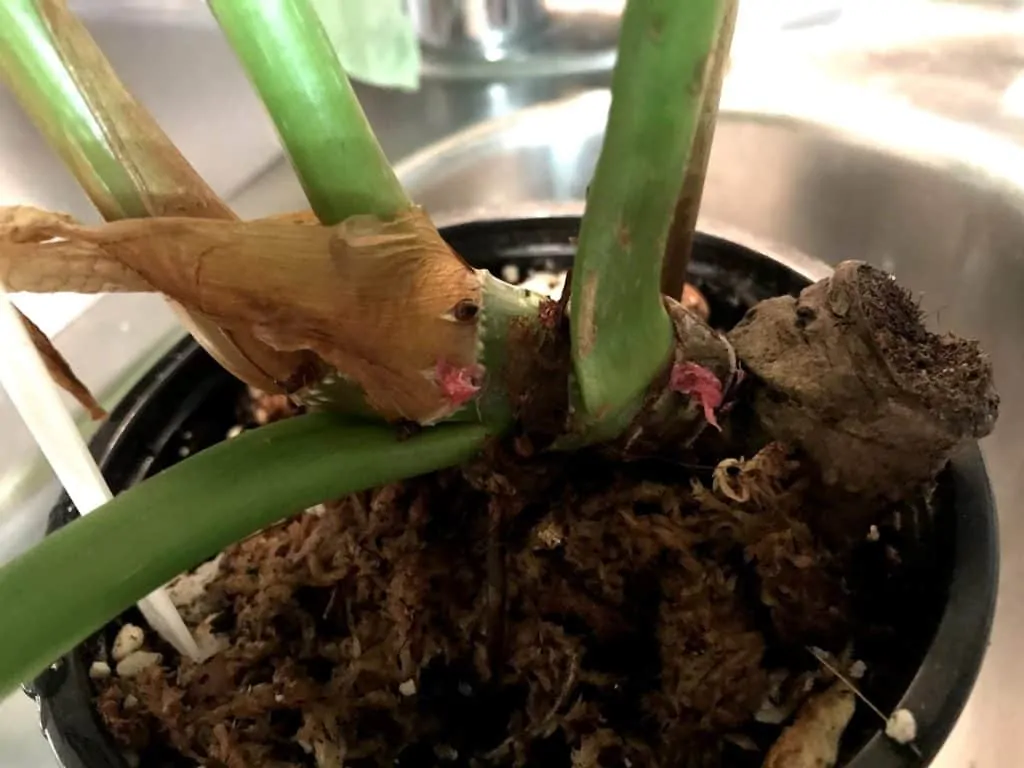
Mystery Philodendron meets Keiki Paste (paste applied on January 14th)
Results:
Nothing ever developed from the points the Keiki paste was applied.
Conclusion Regarding Keiki Cloing Paste
There is no doubt that Keiki paste works for orchids.
I tested it with multiple Phalaenopsis orchids and multiple produced new plantlets or orchids.
The caveat here is that the results are not guaranteed.
Sometimes a new flower stalk emerges (which isn’t bad either), and other times nothing grows.
You need to be wary of applying the Keiki paste when the orchid plant is healthy, when it is not in bloom, and probably not in the deepest winter.
It drains quite a lot of energy from the plant to develop a new clone or offspring.
I had one plant in bloom die completely; another was infested by pests (probably it was more vulnerable or stressed?) right after.
Crazy Keiki Cloning Paste on Other Plants
The results and outcomes are more differentiated when applying Keiki paste on other plants.
I found Keiki paste to work best on Monstera and Philodendron plants when there already was a sign of a new growth point.
In these cases, Keiki paste has been speeding up the process considerably.
But I couldn’t produce a new growth point out of nowhere or revive a very old sleeping node either.
Would I use Keiki paste again? For sure.
It works amazingly for orchids and other plants such as Monstera and Philodendron, and I assume other aroids will considerably speed up new growth points.
Where to buy Keiki Cloning Paste And What Brand to Buy
The best Keiki Paste to buy is the Crazy Keiki Cloning Paste from Southside Plants. The reviews are fantastic, and the rating is great. You can get it directly from Amazon.
Crazy Keiki Cloning Paste
It is mentioned that it might also work well for other plants such as Nephentes and Bonsais, where it is said to promote branch growth.
Usually, you will see results within 2-6 weeks with the Crazy Keiki Cloning Paste from Southside Plants.
Frequently Asked Questions About Keiki Cloning Paste
Where can I buy Keiki Paste?
Your best chance of getting a Keiki Paste is either Amazon or eBay. On both platforms, you will find multiple vendors selling Keiki Cloning Pastes. Different pastes and brands are available that vary slightly in terms of the ingredients they use. Most of the cloning pastes will use Cytokinin and/or other plant growth hormones.
Where can I get Keiki Cloning Paste in Europe?
Like the rest of the world, Amazon and eBay are your go-to sources for orchid Keiki Paste. Some of the brands available in the US might be hard to acquire or will even be unavailable. Considerable shipping costs apply if you try to get a specific brand of Cloning Paste from overseas.
Can I make my own Keiki Paste?
Of course, you can. Most things can be done DIY if you know how it is done and has the motivation, resources, skills, and knowledge to do so.
Essentially, you will need 1g BA/BAP in 1kg of lanolin or some kind of cream, such as wrinkle cream, as a substitute for lanolin.
How long is the lifespan of Keiki Cloning Paste?
Some vendors guarantee that their paste is guaranteed for up to a year, but some people reported back that their Keiki past was still working after a couple of years.
How much does orchid Cloning Paste cost?
From 5 USD to roughly 20 USD, you are depending on brand and amount.
How long does it take for a new Keiki to appear?
It will usually take between 4-8 weeks until a Keiki appears. But it depends on many factors, and there is no guarantee that any Keiki forms. It can very well just be a flower spike or nothing at all.
Can Keiki paste be used for plants other than orchids?
It is said that Keiki past may work for several other plants as well as one of the main ingredients Cytokinin, is used in plants in general for cell division. Monstera, Philodendron, and many more plants have reported successful cloning attempts.
What is the success/failure rate when using Keiki Paste?
We have not applied it to enough plants to tell yet, and the Cloning Paste has yet to prove any kind of success.
How do I remove the Keiki from the orchid?
Once roots emerge and are at least 1-3” or 2.6- 7.6cm long, your Keiki is ready to be removed from the mother plant.
Keiki cloning paste works for growing keikis on orchids and can also work on other plants.

Daniel has been a plant enthusiast for over 20 years. He owns hundreds of houseplants and prepares for the chili growing seasons yearly with great anticipation. His favorite plants are plant species in the Araceae family, such as Monstera, Philodendron, and Anthurium. He also loves gardening and is growing hot peppers, tomatoes, and many more vegetables.
Last update on 2024-04-19 / Affiliate links / Images from Amazon Product Advertising API


